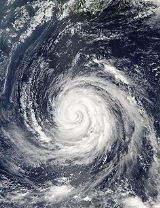
Typhoon Rusa
Encyclopedia
Typhoon Rusa was the 21st JTWC tropical depression (21W), the 15th named storm, and the 10th typhoon of the 2002 Pacific typhoon season
. The name of the typhoon, which was contributed by Malaysia, is a type of sambar deer most commonly seen in secondary forests on gently sloping terrain.
on August 19. The convection became better organized, and with good diffluence aloft and light to moderate wind shear, it organized into Tropical Depression 21W on August 22. It tracked northwestward under the influence of a low to mid-level ridge to its northeast. On the 23rd, the depression was upgraded to Tropical Storm Rusa, and with more favorable outflow, Rusa became a typhoon on the 24th.
On August 25 to the 26th, Rusa rapidly intensified to a peak of 135 mi/h winds. Dry air was entrained in the circulation, and Rusa weakened as it continued northwestward. An eyewall replacement cycle further weakened the storm, and Rusa was a 100 mi/h typhoon 12 hours after peaking. As the new eyewall contracted, the wind field expanded, and Rusa became a 110 mi/h typhoon. At this time, it resembled an annular typhoon
, with a 120 nautical miles (222.2 km) wide eye and little banding.
Rusa slowly weakened as it continued to the northwest. A low pressure system over Japan eroded the ridge, bringing Rusa to the north. There, it hit southern South Korea
on August 31 as an 80 mi/h typhoon. Rusa turned to the northeast, and became extratropical over the Sea of Japan
(East Sea) on September 1.
Because of Rusa's death toll and damage, the name was retired and replaced with Nuri.
2002 Pacific typhoon season
A Tropical Cyclone Formation Alert was issued on July 19 for a Tropical Disturbance that was located east of the international Date Line. The Next day the Disturbance crossed the international date line and was classified as a Tropical Depression by the JMA. The JMA then upgraded the depression to...
. The name of the typhoon, which was contributed by Malaysia, is a type of sambar deer most commonly seen in secondary forests on gently sloping terrain.
Meteorological history
The eastern periphery of the monsoon trough spawned a tropical disturbance east of PohnpeiPohnpei
Not to be confused with Pompeii, the ancient city destroyed by Vesuvius in AD 79.Pohnpei "upon a stone altar " is the name of one of the four states in the Federated States of Micronesia , situated among the Senyavin Islands which are part of the larger Caroline Islands group...
on August 19. The convection became better organized, and with good diffluence aloft and light to moderate wind shear, it organized into Tropical Depression 21W on August 22. It tracked northwestward under the influence of a low to mid-level ridge to its northeast. On the 23rd, the depression was upgraded to Tropical Storm Rusa, and with more favorable outflow, Rusa became a typhoon on the 24th.
On August 25 to the 26th, Rusa rapidly intensified to a peak of 135 mi/h winds. Dry air was entrained in the circulation, and Rusa weakened as it continued northwestward. An eyewall replacement cycle further weakened the storm, and Rusa was a 100 mi/h typhoon 12 hours after peaking. As the new eyewall contracted, the wind field expanded, and Rusa became a 110 mi/h typhoon. At this time, it resembled an annular typhoon
Annular hurricane
An annular hurricane, also known as a truck tire or doughnut hurricane, is a tropical cyclone in the Atlantic or Eastern Pacific Oceans that features a large, symmetric eye surrounded by a thick ring of intense convection. This type of storm is not prone to the fluctuations in intensity associated...
, with a 120 nautical miles (222.2 km) wide eye and little banding.
Rusa slowly weakened as it continued to the northwest. A low pressure system over Japan eroded the ridge, bringing Rusa to the north. There, it hit southern South Korea
South Korea
The Republic of Korea , , is a sovereign state in East Asia, located on the southern portion of the Korean Peninsula. It is neighbored by the People's Republic of China to the west, Japan to the east, North Korea to the north, and the East China Sea and Republic of China to the south...
on August 31 as an 80 mi/h typhoon. Rusa turned to the northeast, and became extratropical over the Sea of Japan
Sea of Japan
The Sea of Japan is a marginal sea of the western Pacific Ocean, between the Asian mainland, the Japanese archipelago and Sakhalin. It is bordered by Japan, North Korea, Russia and South Korea. Like the Mediterranean Sea, it has almost no tides due to its nearly complete enclosure from the Pacific...
(East Sea) on September 1.
Impact
Rusa brought heavy rains and flooding to South Korea, amounting to 36 inches (914.4 mm) in some areas. 113 people were killed in the country, making it one of the deadliest typhoons to hit South Korea. Extensive crop and property damage amounted to $6 billion (2002 USD).Because of Rusa's death toll and damage, the name was retired and replaced with Nuri.
See also
- List of tropical cyclones

